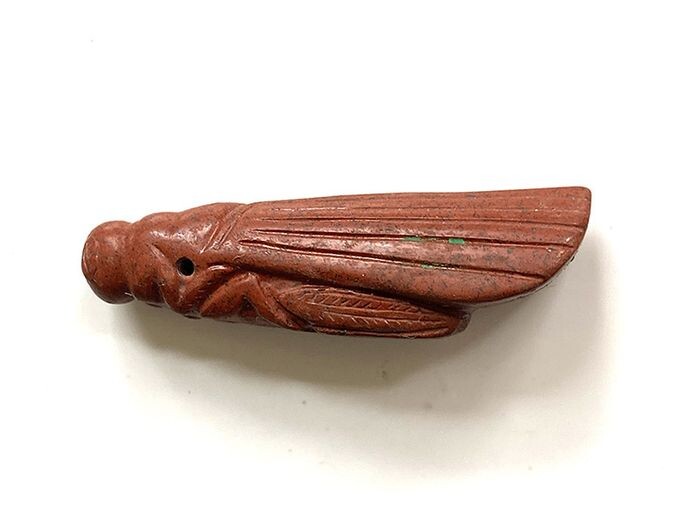Ancient Egyptian, JasperGrasshopper Amulet, (for "riches", "plenty" or "fertility" )- 3.8 cm - (1)
Grasshopper Amulet, (for "riches", "penty" or "fertility") In the style of Egypt, c. 2nd Century B. C. Ptolemaic Period Carved red jasper amulet of a grasshopper modelled in the round and pierced for suspension. Size: 3. 8 cm. L. Material: Jasper Culture: In the style of Egypt, c. 2nd Century B. C. Condition: Intact Jasper is a hard, often mottle mostly red stone, that can be found also in green or yellow forms. It is a form of Quartz (silicium dioxide) Only in the red and green varieties that were found in Ancient Egypt, mostly in the localities of the Eastern Desert, Amulets were made in Egypt. HNMT (Khenmet) , the ancient word for the red form of jasper, was derived from a verb: "chnm" (Chenem) what meant as much as "to delight", and links the stone with a very positive aspect of the colour red, that is the colour or blood with all the connotations and connections to it of energy, dynamism, power and even the idea of life itself. It was the red stone that was used "par excellence" It was prescribed in the Book of the Dead in chapter 156 as the material to use for an amulet called the Girdle Tie of Isis. Here in this case it is used to represent a locust or grasshopper, an animal that was connected to the proliferation of life as when they come, they come in great numbers. This type of amulets occur both in the later Old Kingdom and Eighteenth Dynasty. They are always very naturalistically and carfully shaped. Because of the reproductive behaviour of this insect, the amulet was used most probably to bestow fertility on ist owner. Its way of swarming may also have led to connotation of "plenty" and "riches" But in the famous pyramid texts, the utterances 467 and 627 speak of ascent to the heaven in the form of a grashopper or a locust. That could be suggesting that the amulet had a purely funerary use to it. Provenance: From an old British private collection, formed between 1975 and 1985. The seller guarantees that this item has been legally acquired & will be legally exported, related documents seen by Catawiki. This item do not need an export licence within the EU. The seller will inform the buyer if it needs a UK export licence outside the EU Worldwide shipping by Registered Mail. Comes with a Certificate of Authenticity It is believed that certain gemstones and minerals have beneficial health and spiritual properties. Catawiki cannot guarantee or be held liable for these suggested attributes which have no scientific evidence and cannot be considered a substitute for traditional medical treatment.
[ translate ]View it on
Estimate
Time, Location
Auction House
Grasshopper Amulet, (for "riches", "penty" or "fertility") In the style of Egypt, c. 2nd Century B. C. Ptolemaic Period Carved red jasper amulet of a grasshopper modelled in the round and pierced for suspension. Size: 3. 8 cm. L. Material: Jasper Culture: In the style of Egypt, c. 2nd Century B. C. Condition: Intact Jasper is a hard, often mottle mostly red stone, that can be found also in green or yellow forms. It is a form of Quartz (silicium dioxide) Only in the red and green varieties that were found in Ancient Egypt, mostly in the localities of the Eastern Desert, Amulets were made in Egypt. HNMT (Khenmet) , the ancient word for the red form of jasper, was derived from a verb: "chnm" (Chenem) what meant as much as "to delight", and links the stone with a very positive aspect of the colour red, that is the colour or blood with all the connotations and connections to it of energy, dynamism, power and even the idea of life itself. It was the red stone that was used "par excellence" It was prescribed in the Book of the Dead in chapter 156 as the material to use for an amulet called the Girdle Tie of Isis. Here in this case it is used to represent a locust or grasshopper, an animal that was connected to the proliferation of life as when they come, they come in great numbers. This type of amulets occur both in the later Old Kingdom and Eighteenth Dynasty. They are always very naturalistically and carfully shaped. Because of the reproductive behaviour of this insect, the amulet was used most probably to bestow fertility on ist owner. Its way of swarming may also have led to connotation of "plenty" and "riches" But in the famous pyramid texts, the utterances 467 and 627 speak of ascent to the heaven in the form of a grashopper or a locust. That could be suggesting that the amulet had a purely funerary use to it. Provenance: From an old British private collection, formed between 1975 and 1985. The seller guarantees that this item has been legally acquired & will be legally exported, related documents seen by Catawiki. This item do not need an export licence within the EU. The seller will inform the buyer if it needs a UK export licence outside the EU Worldwide shipping by Registered Mail. Comes with a Certificate of Authenticity It is believed that certain gemstones and minerals have beneficial health and spiritual properties. Catawiki cannot guarantee or be held liable for these suggested attributes which have no scientific evidence and cannot be considered a substitute for traditional medical treatment.
[ translate ]


